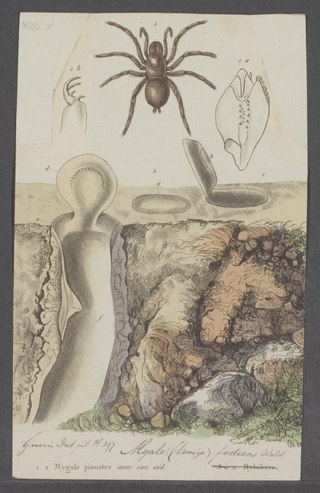
The family Dipluridae, known as curtain-web spiders are a group of spiders in the infraorder Mygalomorphae, that have two pairs of booklungs, and chelicerae (fangs) that move up and down in a stabbing motion. A number of genera, including that of the Sydney funnel-web spider (Atrax), used to be classified in this family but have now been moved to Hexathelidae.

The family Cyrtaucheniidae, known as wafer-lid trapdoor spiders, are a widespread family of Mygalomorphae spiders.

Hexathelidae is a family of mygalomorph spiders. It is one of a number of families and genera of spiders known as funnel-web spiders. In 2018, the family was substantially reduced in size by genera being moved to three separate families: Atracidae, Macrothelidae and Porrhothelidae. Atracidae includes the most venomous species formerly placed in Hexathelidae.
Plesiolena is a small genus of South American mygalomorph spiders in the family Actinopodidae. It was first described by Pablo A. Goloboff and Norman I. Platnick in 1987, and it has only been found in Chile. The name is a combination of "plesiomorphy" and the genus Missulena. As of November 2021 it contains only 2 species: P. bonneti and P. jorgelina.

Microstigmatidae is a small family of spiders with about 25 described species in eight genera. They are small ground-dwelling and free-living spiders that make little use of silk.

Nemesiidae, also known as funnel-web trapdoor spiders, is a family of mygalomorph spiders first described by Eugène Simon in 1889, and raised to family status in 1985. Before becoming its own family, it was considered part of "Dipluridae".

Barychelidae, also known as brushed trapdoor spiders, is a spider family with about 300 species in 42 genera.

Cteniza is a small genus of Old World trapdoor spiders found in France and Italy, first described by Pierre André Latreille in 1829. As of April 2019, it contains only three species: C. genevieveae, C. moggridgei, and C. sauvagesi.

Sason is a genus of bark-dwelling brushed trapdoor spiders first described by Eugène Simon in 1887. It is distributed from the Seychelles through India to northern Australia. The closest related genus seems to be the monotypic Paracenobiopelma.
Hiboka is a monotypic genus of East African armored trapdoor spiders containing the single species, Hiboka geayi. It was first described by L. Fage in 1922, and has only been found on Madagascar. Originally placed with the Ctenizidae, it was moved to the armored trapdoor spiders in 1985.

Segregara is a genus of African armored trapdoor spiders that was first described by R. W. E. Tucker in 1917. As of May 2019 it contains only three species, all found in South Africa: S. abrahami, S. paucispinulosa, and S. transvaalensis. Originally placed with the Ctenizidae, it was moved to the Idiopidae in 1985.

The Euctenizidae are a family of mygalomorph spiders. They are now considered to be more closely related to Idiopidae.
Idioctis is a genus of brushed trapdoor spiders that was first described by L. Koch in 1874.
Sasonichus is a monotypic genus of Asian brushed trapdoor spiders containing the single species, Sasonichus sullivani. It was first described by Reginald Innes Pocock in 1900, and has only been found in India. The species Sipalolasma arthrapophysis was briefly placed here before being moved to Sipalolasma in 1985.
Tigidia is a genus of brushed trapdoor spiders first described by Eugène Simon in 1892.
Teranodes is a genus of Australian funnel-web spiders that was first described by Robert John Raven in 1985. As of May 2019 it contains only two species: T. montanus and T. otwayensis. It was originally given the name "Terania", but it was later changed to "Teranodes" when it was discovered that the name was already in use for a genus of beetles.

Calisoga is a genus of spiders in the family Nemesiidae, first described in 1937 by Ralph Vary Chamberlin. As of February 2019, it contains five species, all in the USA.
Kwonkan is a genus of Australian mygalomorph spiders first described by Barbara York Main in 1983. It was originally assigned to Dipluridae, but was later assigned to Nemesiidae due to similarities to the genus Aname, before being transferred to the family Anamidae in 2010. The known distribution of described species in the genus is restricted to the states of South Australia (SA) and Western Australia (WA). Yilgarnia is now considered a synonym for this genus, and its type species is assigned to Kwonkan currycomboides.
Pionothele is a genus of African mygalomorph spiders in the family Pycnothelidae. It was first described by William Frederick Purcell in 1902. As of June 2020 it contains 2 species, found in Namibia and South Africa: P. gobabeb, and P. straminea. Originally placed with the Ctenizidae, it was transferred to the funnel-web trapdoor spiders in 1985, then to the Pycnothelidae in 2020.
Melognathus is a monotypic genus of southeast Asian tarantulas containing the single species, Melognathus dromeus. It was erected in 1917 for a holotype collected from a ship that visited southeast Asia. In 1985, the species was moved to Cyriopagopus because the autapomorphies were not considered significant enough to warrant a new genus. Opinions between biologists were split, some using the original name and some using Cyriopagopus. In a 2019 report, Gabriel and Sherwood pointed out that in addition to the differences in pedipalp morphology, the holotype exhibits leg features that indicate an arboreal species, while species of Cyriopagopus are largely terrestrial. The ambiguous location of the holotype has left room for speculation, but as of February 2022 the World Spider Catalog accepts this genus.








